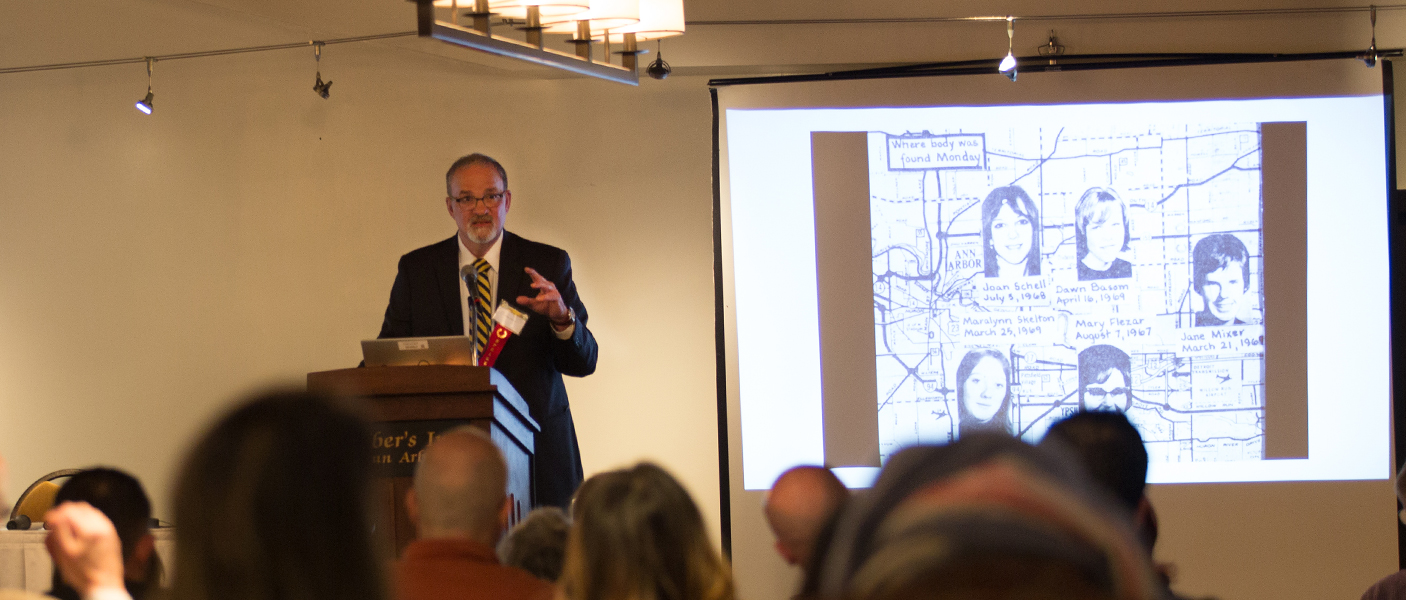

The University of Michigan hosted nearly 100 forensic pathologists, medical examiners, death investigators, coroners, and others at Weber’s Inn in Ann Arbor, Michigan, for its 10th Annual Advances in Forensic Medicine and Pathology, May 9-10, 2019, for two full days of continuing education. Speakers and attendees from across the globe gathered to learn and contribute to this exceptional conference. Dr. Jeffrey Jentzen, Professor, and Director of Autopsy and Forensic Services, Department of Pathology, Michigan Medicine kicked off the conference with an intriguing review of the Ann Arbor/Ypsilanti Co-Ed Murders from 1967-1969, during which time 7 females, ages 13-23, were murdered by a serial killer, then dumped in open areas.
—
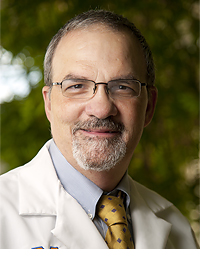 Dr. Jentzen noted that serial killers are a relatively new phenomenon, generally starting in the early 1960’s with the Boston Strangler. Per the FBI definition, serial killers have at least 3 victims, killed over time and most have a sexual component. The motivation is psychological gratification, whether that be sexual, attention seeking, or other aspects of the psyche. A “cooling off” period between murders distinguishes serial killing from mass or spree killings, in which two or more locations may be involved, but no cooling off period is present. Most are highly organized, intelligent and socially competent individuals with some anti-social behaviors, but no pattern of abuse. Killing is planned and victims are often strangers, selected at random. Serial killers go through a series of phases beginning with the aura phase when intent is developed. This is followed by a trolling phase, where the search for potential victims initiates, then the wooing phase, when victims are captured and bondage is involved. The murder phase may be prolonged or rapid, followed by the totem phase where material (garments, jewelry, or pieces of the body) are collected as trophies. The final phase is the depression phase, which sets the killer up to restart the cycle. Jentzen also noted that communities respond to serial killers in different ways. Some, like Jeffrey Dahmer and Ted Bundy, are kept alive in the community memory, while others, like these Ann Arbor/Ypsilanti murders, are “forgotten” by the community. Some communities want to portray themselves as “safe” and as such, tend to bury tragedies that do not fit the community’s desired image.
Dr. Jentzen noted that serial killers are a relatively new phenomenon, generally starting in the early 1960’s with the Boston Strangler. Per the FBI definition, serial killers have at least 3 victims, killed over time and most have a sexual component. The motivation is psychological gratification, whether that be sexual, attention seeking, or other aspects of the psyche. A “cooling off” period between murders distinguishes serial killing from mass or spree killings, in which two or more locations may be involved, but no cooling off period is present. Most are highly organized, intelligent and socially competent individuals with some anti-social behaviors, but no pattern of abuse. Killing is planned and victims are often strangers, selected at random. Serial killers go through a series of phases beginning with the aura phase when intent is developed. This is followed by a trolling phase, where the search for potential victims initiates, then the wooing phase, when victims are captured and bondage is involved. The murder phase may be prolonged or rapid, followed by the totem phase where material (garments, jewelry, or pieces of the body) are collected as trophies. The final phase is the depression phase, which sets the killer up to restart the cycle. Jentzen also noted that communities respond to serial killers in different ways. Some, like Jeffrey Dahmer and Ted Bundy, are kept alive in the community memory, while others, like these Ann Arbor/Ypsilanti murders, are “forgotten” by the community. Some communities want to portray themselves as “safe” and as such, tend to bury tragedies that do not fit the community’s desired image.
 Dr. Barry Logan, Sr. Vice President of Forensic Science Initiatives and Chief Scientist at NMS Labs in Willow Grove, PA followed with a discussion on Current Trends in Novel Drug Use and Newly Emerging Compounds. A native of Glasgow, Scottland, Dr. Logan is the premier forensic toxicologist in the United States. Ten years ago, drug panels were looking for opioids, morphine, codeine, and semi-synthetics such as heroin. Today, the scope of testing has expanded significantly to include many novel synthetic analogs, most of which are fentanyl derivatives. Others that we are seeing include drugs in development by pharmaceutical companies for which patents are filed, but the drugs never came to market. These patents are public documents and can be duplicated by those with the appropriate chemical knowledge. U-47700, from the Upjohn Company, is one that has been duplicated by China and we are seeing more often. When opioid prescribing was tightened in 2014, we saw a big increase in illicit opioids including heroin, fentanyl analogs, and carfentanyl, which is extremely potent. With the introduction of Narcan, we are seeing fewer opioid-related deaths. Production of illicit opioids has shifted from China to Mexico along the US southwestern border and trafficked along established cartel drug routes. Synthetic cannabinoids have emerged beginning in 2008, with 175 synthetic cannabinoid agonists identified in the illicit drug supply as of 2018. These are increasing in potency and produce increased fatalities, especially among cardiac-compromised individuals. Mitragynine is an active compound from a plant grown in SE Asia, Kratum. It is considered an energy-boosting supplement, but at higher doses has analgesic properties like Tramadol. Dr. Logan concluded with brief discussions of multiple other drugs including Alpa PDP (gravel, flocka), methalone, and cariprazine, among others.
Dr. Barry Logan, Sr. Vice President of Forensic Science Initiatives and Chief Scientist at NMS Labs in Willow Grove, PA followed with a discussion on Current Trends in Novel Drug Use and Newly Emerging Compounds. A native of Glasgow, Scottland, Dr. Logan is the premier forensic toxicologist in the United States. Ten years ago, drug panels were looking for opioids, morphine, codeine, and semi-synthetics such as heroin. Today, the scope of testing has expanded significantly to include many novel synthetic analogs, most of which are fentanyl derivatives. Others that we are seeing include drugs in development by pharmaceutical companies for which patents are filed, but the drugs never came to market. These patents are public documents and can be duplicated by those with the appropriate chemical knowledge. U-47700, from the Upjohn Company, is one that has been duplicated by China and we are seeing more often. When opioid prescribing was tightened in 2014, we saw a big increase in illicit opioids including heroin, fentanyl analogs, and carfentanyl, which is extremely potent. With the introduction of Narcan, we are seeing fewer opioid-related deaths. Production of illicit opioids has shifted from China to Mexico along the US southwestern border and trafficked along established cartel drug routes. Synthetic cannabinoids have emerged beginning in 2008, with 175 synthetic cannabinoid agonists identified in the illicit drug supply as of 2018. These are increasing in potency and produce increased fatalities, especially among cardiac-compromised individuals. Mitragynine is an active compound from a plant grown in SE Asia, Kratum. It is considered an energy-boosting supplement, but at higher doses has analgesic properties like Tramadol. Dr. Logan concluded with brief discussions of multiple other drugs including Alpa PDP (gravel, flocka), methalone, and cariprazine, among others.
 A discussion of the Opioid Crisis: The Cleveland Experience continued the topic led by Dr. Joseph Felo, Forensic Pathologist and Chief Deputy Medical Examiner for Cuyahoga County Medical Examiner’s Office in Cleveland, OH. Dr. Felo described the historical changes in drug deaths over the past 13 years, noting that heroin was the major cause of death 2011-2014 when Fentanyl increased along with Cocaine. Cocaine is responsible for 40-50% of overall drug deaths in the past five years, but now 75% of drug deaths include Fentanyl. In investigating drug deaths, it is important to go to the scene and observe the body before it is moved – what is surrounding the body, any powders or residues, positioning of the body, pills, syringes, spoons with residues, inhalers, prescription drugs, naloxone. Check in the mouth. Drugs cannot be identified by appearance as they can look like anything. Carfentanyl is only 0.4% of the powder in a mixture. Fentanyl is more potent than heroin. 20 mg of heroin is a lethal dose whereas 2 mg of fentanyl is lethal. Fentanyl is cheap at only 1 penny/dose as compared to heroin at $2.60 per dose. Today, 99% of cases include fentanyl, often in combination with other drugs such as cocaine, heroin, and marijuana. Metamphetamines represent about 3% of cases today. Victims of drug overdose often have edematous foam in the airway, mucus in the airway, pulmonary edema, cerebral edema, extended bladder, alveolar sacs filled with fluid, purplish red in the lungs, and may have a white powder in trachea or lungs. Postmortem toxicology should include hospital samples of blood, serum and urine, if possible, as levels can be falsely elevated or decreased postmortem.
A discussion of the Opioid Crisis: The Cleveland Experience continued the topic led by Dr. Joseph Felo, Forensic Pathologist and Chief Deputy Medical Examiner for Cuyahoga County Medical Examiner’s Office in Cleveland, OH. Dr. Felo described the historical changes in drug deaths over the past 13 years, noting that heroin was the major cause of death 2011-2014 when Fentanyl increased along with Cocaine. Cocaine is responsible for 40-50% of overall drug deaths in the past five years, but now 75% of drug deaths include Fentanyl. In investigating drug deaths, it is important to go to the scene and observe the body before it is moved – what is surrounding the body, any powders or residues, positioning of the body, pills, syringes, spoons with residues, inhalers, prescription drugs, naloxone. Check in the mouth. Drugs cannot be identified by appearance as they can look like anything. Carfentanyl is only 0.4% of the powder in a mixture. Fentanyl is more potent than heroin. 20 mg of heroin is a lethal dose whereas 2 mg of fentanyl is lethal. Fentanyl is cheap at only 1 penny/dose as compared to heroin at $2.60 per dose. Today, 99% of cases include fentanyl, often in combination with other drugs such as cocaine, heroin, and marijuana. Metamphetamines represent about 3% of cases today. Victims of drug overdose often have edematous foam in the airway, mucus in the airway, pulmonary edema, cerebral edema, extended bladder, alveolar sacs filled with fluid, purplish red in the lungs, and may have a white powder in trachea or lungs. Postmortem toxicology should include hospital samples of blood, serum and urine, if possible, as levels can be falsely elevated or decreased postmortem.
 Rebecca Cunningham, MD, Vice President for Health Sciences Research at the University of Michigan Office of Research, described an opioid surveillance system developed in conjunction with the CDC and other organizations to provide real-time information for public health, local communities and others on locations of fatal overdoses and toxicology reports, linked to EMS and hospital emergency department data. The purpose of this is to interrupt potential sales of lethal drugs, identify where greater naloxone doses are needed, and where community services are most useful.
Rebecca Cunningham, MD, Vice President for Health Sciences Research at the University of Michigan Office of Research, described an opioid surveillance system developed in conjunction with the CDC and other organizations to provide real-time information for public health, local communities and others on locations of fatal overdoses and toxicology reports, linked to EMS and hospital emergency department data. The purpose of this is to interrupt potential sales of lethal drugs, identify where greater naloxone doses are needed, and where community services are most useful.
The morning concluded with a 10-year review of the impact of the Goudge hearings in Canada by Dr. Christopher Millroy, Director of the Eastern Ontario Forensic Pathology Unit and Professor at the University of Ottawa, The Ottawa Hospital, Ottawa, Canada. These hearings reviewed the cases of Dr. Charles Smith, a Canadian-trained, pediatric board certified (US) physician, who was appointed as the Chief Coroner at Sick Kids hospital, in spite of having no forensic pathology training. It was determined that several individuals were incarcerated as a result of mistaken cause of death findings by Dr. Smith. 45 cases were identified as of potential concern. Upon further review, this was reduced to 20 cases. Eighteen of them will be moving forward and two of them are in appeal.
As a result of these hearings, a number of changes have been implemented.
Thursday afternoon kicked off with three simultaneous workshops on Investigating Truck Collisions (Abraham Tabry, Esq and Jeffrey Jentzen, MD, PhD), Certifying Drug-Related Deaths (Carl Schmidt, MD), and Interpretation of Gunshot Wounds and Weapons (LokMan Sung, MD).
 Dr. Christopher Millroy returned to discuss Subtle Child Homicide. Child homicide typically occurs before the age of 1 year and nearly always before the age of 5 years. The types of fatal homicide include newborn smothering, battered baby syndrome, head injury and abdominal injury. Fatal child sexual abuse is very rare. Sudden death between the ages of 2-3 years of age is highly suspicious. About 4 % of child death cases are homicides, 1/3 are natural deaths, and 1/3 are accidental, with suicides more common among teens. SIDS (sudden infant death syndrome) for children under age 1 is rarely considered a cause of death any longer. Some are an undetermined cause, some unsafe sleeping environment. Typically, it is multifactorial. To determine the cause of death, complete radiology on every case, do genetic testing for abnormalities such as Long QT syndrome, repeat newborn screening and metabolic studies, visually examine the bones for fractures both new and healed, do histology on all cases. Consider signs of neglect – underweight, fatty liver from starvation. Conduct toxicology studies. Multiple crib deaths may be signs of homicide, but 80-90% of 2nd crib deaths are from natural causes, others may be due to unsafe sleeping conditions/accidental. Only a few are homicides.
Dr. Christopher Millroy returned to discuss Subtle Child Homicide. Child homicide typically occurs before the age of 1 year and nearly always before the age of 5 years. The types of fatal homicide include newborn smothering, battered baby syndrome, head injury and abdominal injury. Fatal child sexual abuse is very rare. Sudden death between the ages of 2-3 years of age is highly suspicious. About 4 % of child death cases are homicides, 1/3 are natural deaths, and 1/3 are accidental, with suicides more common among teens. SIDS (sudden infant death syndrome) for children under age 1 is rarely considered a cause of death any longer. Some are an undetermined cause, some unsafe sleeping environment. Typically, it is multifactorial. To determine the cause of death, complete radiology on every case, do genetic testing for abnormalities such as Long QT syndrome, repeat newborn screening and metabolic studies, visually examine the bones for fractures both new and healed, do histology on all cases. Consider signs of neglect – underweight, fatty liver from starvation. Conduct toxicology studies. Multiple crib deaths may be signs of homicide, but 80-90% of 2nd crib deaths are from natural causes, others may be due to unsafe sleeping conditions/accidental. Only a few are homicides.
Case reports followed with Dr. Millroy presenting the first case of a 9 mo. old Inuit child who passed away during the night, sleeping with his mother on a mattress on the floor. The child had a common Inuit gene variant, CPT1A-P479 variant, which leads to hypoglycemia if not on a ketogenic diet. This variant is found in 70% of infants in the region. Initial thoughts indicated possible death due to unsafe sleeping environment or due to the gene variant. Toxicology came back with lethal levels of dihyphenadrine, which was the cause of death.
 Milad Webb presented a case of sudden “sniffing” death syndrome. Sniffing, huffing, bagging are names for the process of inhaling chemicals to get high, such as air duster cans, shoe polish, nitrous oxide, spray paint, etc. A 39 yr. old female called EMS. She was trying to fall asleep and had sniffed 4 cans of air duster that day. She was alert, oriented, laying on the floor, not feeling well. She vomited but experienced no pain. She was able to walk to the ambulance without assistance and needed minimal care on the trip to the ED, where she was able to ambulate and get into bed on her own. She reported to the ED physician she had been huffing for 24-36 hours continuously, was nauseous and thirsty. Vitals were stable. A nurse entered to place an IV, the patient indicates she didn’t feel well, seizes, then goes limp and dies. Tox report indicated high levels of halogenated hydrocarbon (Freon 152a). This can result in sensitization of myocardium to catecholamine surge. Catecholamine is associated with excitement, fear, exertion, and masturbation. When the patient is sensitized to catecholamine, its release results in sudden cardiovascular collapse. The patient experienced this collapse when she experienced fear of the needle. Attempts to resuscitate her with epinephrine further exacerbated the issue and all hope of survival was lost.
Milad Webb presented a case of sudden “sniffing” death syndrome. Sniffing, huffing, bagging are names for the process of inhaling chemicals to get high, such as air duster cans, shoe polish, nitrous oxide, spray paint, etc. A 39 yr. old female called EMS. She was trying to fall asleep and had sniffed 4 cans of air duster that day. She was alert, oriented, laying on the floor, not feeling well. She vomited but experienced no pain. She was able to walk to the ambulance without assistance and needed minimal care on the trip to the ED, where she was able to ambulate and get into bed on her own. She reported to the ED physician she had been huffing for 24-36 hours continuously, was nauseous and thirsty. Vitals were stable. A nurse entered to place an IV, the patient indicates she didn’t feel well, seizes, then goes limp and dies. Tox report indicated high levels of halogenated hydrocarbon (Freon 152a). This can result in sensitization of myocardium to catecholamine surge. Catecholamine is associated with excitement, fear, exertion, and masturbation. When the patient is sensitized to catecholamine, its release results in sudden cardiovascular collapse. The patient experienced this collapse when she experienced fear of the needle. Attempts to resuscitate her with epinephrine further exacerbated the issue and all hope of survival was lost.
Dr. Martin Ishikawa, reported on a natural death case. A 62 yr old Caucasian male with no medical history other than sleep apnea suddenly died while hiking in Hawaii. He was 6’7” and weighed 290 pounds. He had no injuries. Examination revealed an enlarged heart, with right side slightly dilated. No focal cardiac lesions. Minor atherosclerosis and kidney changes, gall stones, nodular prostate. Nothing exceptional for his age. Postmortem toxicology indicated caffeine in his blood. Histology revealed giant cells, some necrosis, numerous eosinophils. Myocardial cells are dying. The major differential diagnosis is sarcoidosis, which has characteristic well-formed granulomas diffusely involving the myocardium. Giant cell myocarditis is differenced by its abundant eosinophils, perivascular distribution of fibrosis, giant cells and lack of well-formed granulomas. Cause of death is Giant Cell Myocarditis.
Dr. Joseph Felo presented a case on fatal hemoperitoneum, an unusual complication of percutaneous endoscopic gastrostomy. An 82 yr. old white male with cardiovascular disease, COPD and chronic malnutrition has a PEG tube inserted using the standard Posky technique without difficulty. No evidence of bleeding. Within 5 minutes, he developed hypoxia, hypotension. He was on DNR status and died within 55 minutes of the procedure. An autopsy was requested by the family. The PEG tube was inserted to the left of the zyphoid process. The patient had a classic CABG scar. No oozing or pus around the PEG tube. Some hemorrhage with 1.2 liters of blood in the abdominal cavity. The PEG tube had perforated the greater omentum, and torn through the gastroepiploic artery, along the base of the stomach. Death was ruled as natural – therapeutic complication. As a known risk factor, this does not imply malpractice.
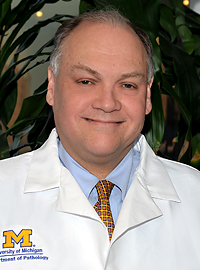 Dr. Carl Schmidt presented on a 4-month-old child that died in the care of his father, who had prior misdemeanors and felonies. Father called 911 and indicated he fell asleep with the child in his arms, rolled over the child and woke up in time to resuscitate the child. Upon arrival, the child was brain dead. Police are texted to indicate the child has skull fractures and lung bruising with anterior anal lacerations. Police arrested the father. Upon autopsy, the skull fractures were actually unfused bones at the base of the skull. There was no subdural hemorrhage. No fractures, no lung contusions, nothing. The anal lacerations were anal fissures due to constipation, the rectum was normal. Father was eventually exonerated based on the findings of the autopsy.
Dr. Carl Schmidt presented on a 4-month-old child that died in the care of his father, who had prior misdemeanors and felonies. Father called 911 and indicated he fell asleep with the child in his arms, rolled over the child and woke up in time to resuscitate the child. Upon arrival, the child was brain dead. Police are texted to indicate the child has skull fractures and lung bruising with anterior anal lacerations. Police arrested the father. Upon autopsy, the skull fractures were actually unfused bones at the base of the skull. There was no subdural hemorrhage. No fractures, no lung contusions, nothing. The anal lacerations were anal fissures due to constipation, the rectum was normal. Father was eventually exonerated based on the findings of the autopsy.
—
The day wrapped up with a poster session and reception, with Dr. Milad Webb winning the Best Poster presentation for his poster entitled “Kratom: An Herbal Overdose". This was followed by dinner and the Dolores M. and John E. Finger, MD Forensic Lecture by award winner, Ian Burney, PhD. His lecture was entitled “Spatters and Lies: Contrasting Forensic Cultures in the Trials of Sam Sheppard, 1954-66.”
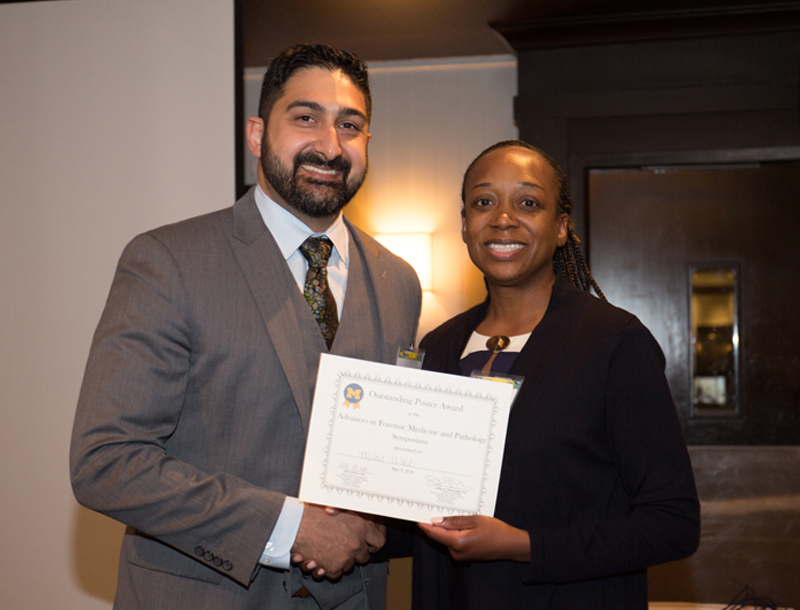
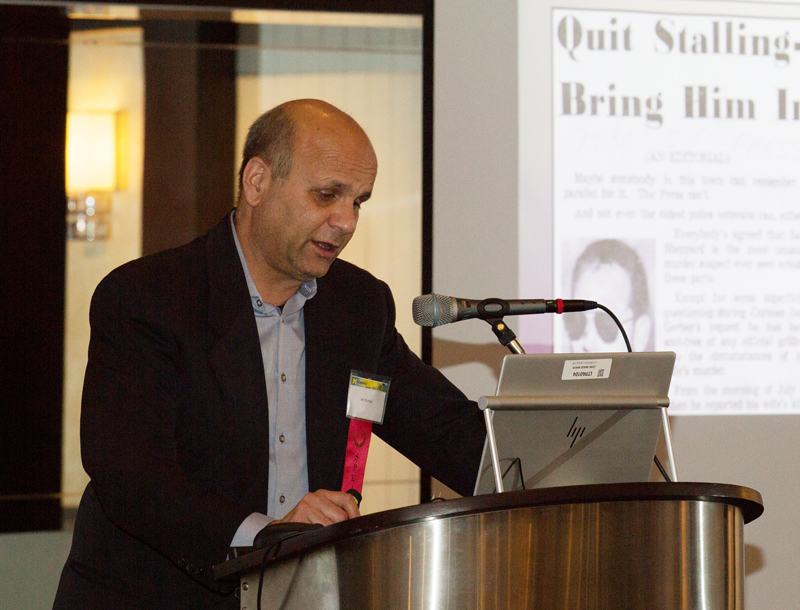
Friday, May 10th kicked off with a warm welcome by Dr. Jeffrey Jentzen then quickly onto Ian Burney’s lecture, The Making of English CSI, a review of his book of the same name on the 1953 investigation into the 10 Rillington Place Murders. This book merged the themes of interaction and reconfiguration of forensic body/mortuary-based investigation with the forensics of things – the scientific harvesting, collection, and analysis of crime scene places. He reviewed the history of death investigations in England and the contributions of the Austrian investigating magistrate, Hans Gross, with his 1893 detailed crime scene investigations manual (900 pages), as well as the impacts of English pathologists Bernard Stillsbury and Keith Simpson. He then described the 10 Rillington Place Murders and the outcomes of the death investigations.

 Judges Stephanie Domitrovich, PhD and W. Milton Nuzum, III, were invited back to our conference this year to host another interactive “you be the judge” session on cutting-edge issues at the intersection of law and science. The focus was on the use of cutting-edge scientific results as evidence based on Daubert and Frye. The Frye test evaluates if a particular procedure has found general acceptance in the relevant scientific community. The witness is qualified by expert knowledge, skill, experience, training or education. The judge cannot be trusted to make this determination of general acceptance due to lack of knowledge. Under Daubert, the trial judge is given the responsibility to make the determination using a non-exclusive list of questions:
Judges Stephanie Domitrovich, PhD and W. Milton Nuzum, III, were invited back to our conference this year to host another interactive “you be the judge” session on cutting-edge issues at the intersection of law and science. The focus was on the use of cutting-edge scientific results as evidence based on Daubert and Frye. The Frye test evaluates if a particular procedure has found general acceptance in the relevant scientific community. The witness is qualified by expert knowledge, skill, experience, training or education. The judge cannot be trusted to make this determination of general acceptance due to lack of knowledge. Under Daubert, the trial judge is given the responsibility to make the determination using a non-exclusive list of questions:
The judges presented a series of cases upon which the audience voted whether or not the evidence should be admitted under Frye or Daubert, which often resulted in split votes. It was an entertaining and educational presentation.
 Rudolph Castellani, MD, Professor of Pathology and Neuroscience, Section Chief of Neuropathology, Vice Chair for Research and Director of Autopsy Service at West Virginia University and Rockefeller Neuroscience Institute addressed “The (lack of) Appropriateness of CTE for Death Certification”, or the issue of the status of neurotrauma leading to progressive encephalopathy in athletes and others with head trauma. This is sometimes called being “Punch drunk” or having “boxer’s brain”, and is currently the focus of progressive dementia in football players. Prior to the 20th century, boxers often fought daily, sometimes multiple times per day, which resulted in a neurological decline. A study of 224 boxers revealed that just 17% had neurological signs not attributed to another disease. Of these, 6% could be considered “punch drunk”, all of whom boxed prior to WWII. The condition was not progressive in most cases and some boxers improved over time. No cases of dementia pugilistica have been seen in the 20thcentury. Castellani argued that current diagnosis of CTE in athletes due to levels of Tau in the brain and the presence of “tangles” are not diagnostic and is subjective. No robust studies have been conducted to determine cause and effect and many cases of CTE have been misdiagnosed and are actually other disease processes. CTE should not be used as a cause of death on death certificates.
Rudolph Castellani, MD, Professor of Pathology and Neuroscience, Section Chief of Neuropathology, Vice Chair for Research and Director of Autopsy Service at West Virginia University and Rockefeller Neuroscience Institute addressed “The (lack of) Appropriateness of CTE for Death Certification”, or the issue of the status of neurotrauma leading to progressive encephalopathy in athletes and others with head trauma. This is sometimes called being “Punch drunk” or having “boxer’s brain”, and is currently the focus of progressive dementia in football players. Prior to the 20th century, boxers often fought daily, sometimes multiple times per day, which resulted in a neurological decline. A study of 224 boxers revealed that just 17% had neurological signs not attributed to another disease. Of these, 6% could be considered “punch drunk”, all of whom boxed prior to WWII. The condition was not progressive in most cases and some boxers improved over time. No cases of dementia pugilistica have been seen in the 20thcentury. Castellani argued that current diagnosis of CTE in athletes due to levels of Tau in the brain and the presence of “tangles” are not diagnostic and is subjective. No robust studies have been conducted to determine cause and effect and many cases of CTE have been misdiagnosed and are actually other disease processes. CTE should not be used as a cause of death on death certificates.
Sudden Unexpected Deaths with Epilepsy (SUDEP) was the next topic, presented by Dr. Carl Schmidt. Epilepsy is having 2 or more unprovoked seizures more than 24 hours apart. 1 in 100 people have epilepsy, with an 11-fold higher mortality rate. Among young adults, epilepsy deaths are 24-27-fold higher than the general population. Epilepsy is often found in conjunction with other medical conditions such as diabetes and heart disease and absence seizures can be a herald for psychiatric illnesses. Epilepsy takes multiple forms. There are reading-induced seizures that begin with jerks in the jaw and can progress to full convulsions; absence seizures where the patient has a lapse of consciousness; video-game induced seizures; flashing light-induced seizures and seizures acquired due to stroke or trauma. Drugs of abuse can lower the threshold for seizures, especially cocaine, and many genetic conditions are associated with seizures. Sleep deprivation can cause seizures. Some are idiopathic.
The seizures can be fairly minor, such as an absence seizure where the individual has a brief lapse of consciousness to a grand mal seizure, where severe convulsions occur. Provoked seizures, caused by fever, drugs or withdrawals are different than epilepsy. SUDEP is quite common, but the best way to make determinations are often from evidence found at the scene. SUDEP victims are often in strange positions, wrapped up in blankets, in bathtubs, or surrounded by displaced objects. There are often phenobarb or dilatin or other medications in the home. Brains should be examined after fixation, the tongue may be bitten, foci pneumonia may be present. Sometimes stroke or trauma can be found or tumors seen. Other findings may include parasites, especially cystopsychosis from pork, sclerosis in the hippocampus, or vascular malformations may have ruptured during seizure activity.
Dr. Milad Webb continued the discussion on brain-related deaths by presenting “The Neuropathology of Sudden Death.” Intracranial lesions can be related to deaths, but are also frustrating to diagnose due to our limited understanding of the brain. The primary mechanisms of sudden death is due to intracranial insults, resulting in rapid death caused by intracranial pressure and obstructive hydrocephalus. Sudden death can occur when bleeding in the brain occurs, which is very caustic to the brain tissue. This can set off a huge autonomic discharge, cardiac arrest, and severe ischemia due to vasal spasm. The rapid increase in pressure on the brain will cause death to occur due to vascular collapse in the brain. Hallmark changes are not seen unless it happens more slowly, then one can see a lateral shift, midline shift or the brain herniating through hard boundaries as well as pressure necrosis. Another major mechanism is obstructive hydrocephalis, which can develop quickly or over time. The posterior fossa obstruction is rapidly fatal. Intracranial infections are another cause, particularly meningococcal infections, which are accompanied by petechial rashes. Waterhouse friderichsen syndrome can also result from a severe meningitis infection. At times, ear and oral infections can spread to the brain, resulting in purulent ventriculits in the frontal lobe. Brain tumors account for about 8% of massive intracerebral hemorrhages with 50% of bleeds being the first manifestation of the tumor. Finally, various types of trauma can result in brain hemorrhages, swelling or blockages resulting in pressure-related deaths. To diagnose, get a complete history, consider whether fresh or fixed formalin will better serve you, take lots of photos to document findings, take time to do a thorough dissection and consider a neuropathology consultation if necessary.
Dr. Joseph Felo returned after lunch to discuss an investigation into asphyxial deaths. Asphyxia is a common pathway in many types of deaths and have few physical findings other than petechial hemorrhages and discoloration of skin. Petechial hemorrhages occur distal to the pressure point, often in the face, eyes skin or sometimes the epiglottis or larynx. Cyanosis, a purple cast to the skin, is evidence of a lack of oxygen while cherry red skin indicates carbon monoxide intoxication, cyanide poisoning or hypothermia. Asphyxia is caused by insufficient oxygen, either environmentally or mechanically. Oxygen can be replaced by carbon monoxide, methane, propane, butane, nitrogen or helium in the air and will result in asphyxia. Mechanical means include trauma or pressure that prevents normal respiration. This can be applied pressure or positional, where you cannot move the chest due to the physical position of the body – contorted, upside down, kinking of the neck. Smothering occurs when the airways are externally obstructed. Other types include drowning, hanging – both suicide and autoerotic, strangulation, chemicals (i.e. hydrogen sulfide), choking, and aspiration. Witness statements, evidence at the scene and subtle signs of skin color, petechial hemorrhages are needed to diagnose. It is often a diagnosis of exclusion.
 Dr. Allecia Wilson, Assistant Professor and Director of Residency Training Program, University of Michigan Department of Pathology, continued the discussion on organ donation in traumatic infant deaths. She was taught if a baby died, organs could not be donated as there may be suspicions of child abuse and you couldn’t do anything that would interfere with determining the cause of death. Wilson then discussed how, working with Gift of Life, she was able to develop a protocol that would enable the collection of all necessary evidence for the pursuit of legal cases while also enabling donation of certain organs. She is present, when possible, at the cribside where the child died, prior to being moved for the surgical processes and is able to photograph each step of the way so all the data is captured. In addition, she can guide the surgeons on which organs can be harvested and which need to remain with the infant, depending on the damage present. She also conducts a full body CT scan prior to starting so she is able to do a 3D reconstruction after the fact. Best practices include communicating often and early with law enforcement, Gift of Life, prosecutor; getting access to the body prior to the body being cleaned and donated to document pattern injuries and bite marks; be present during the donation surgery and photograph each stage prior to moving or cutting anything; and the investigator needs to be able to dictate what is and isn’t touched. In this way, pediatric homicides can be used for organ donations without compromising the quality of the autopsy and evidence recovered. Trauma and injuries can be thoroughly documented.
Dr. Allecia Wilson, Assistant Professor and Director of Residency Training Program, University of Michigan Department of Pathology, continued the discussion on organ donation in traumatic infant deaths. She was taught if a baby died, organs could not be donated as there may be suspicions of child abuse and you couldn’t do anything that would interfere with determining the cause of death. Wilson then discussed how, working with Gift of Life, she was able to develop a protocol that would enable the collection of all necessary evidence for the pursuit of legal cases while also enabling donation of certain organs. She is present, when possible, at the cribside where the child died, prior to being moved for the surgical processes and is able to photograph each step of the way so all the data is captured. In addition, she can guide the surgeons on which organs can be harvested and which need to remain with the infant, depending on the damage present. She also conducts a full body CT scan prior to starting so she is able to do a 3D reconstruction after the fact. Best practices include communicating often and early with law enforcement, Gift of Life, prosecutor; getting access to the body prior to the body being cleaned and donated to document pattern injuries and bite marks; be present during the donation surgery and photograph each stage prior to moving or cutting anything; and the investigator needs to be able to dictate what is and isn’t touched. In this way, pediatric homicides can be used for organ donations without compromising the quality of the autopsy and evidence recovered. Trauma and injuries can be thoroughly documented.
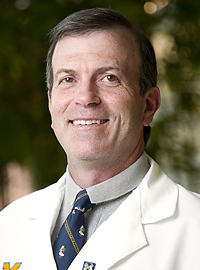 Dr. Richard Lieberman, Associate Professor of Pathology and Obstetrics and Gynecology at Michigan Medicine continued the afternoon with a case study of a 13-year-old girl with a complete hydatidiform mole in a trial for sexual assault. A 13-year-old girl was diagnosed with a septic molar pregnancy, which is pregnancy without a fetus. She experienced an enlarged uterus, elevated HGV and urine testing returned positive for pregnancy. Operative findings revealed there were no fetal blood vessels or NRBCs, just the placenta. This type of pregnancy occurs when an egg is fertilized and there is a duplication of the paternal chromosome and an expulsion of the material chromosome, creating a homologous diandry. This results in no fetal development and an abnormal placenta. Hydropic chorionic villi, no fetal growth, no nucleated blood cells, no p57 expression. The uterine contents are 100% paternal in origin. This occurs in 1:500 to 1000 pregnancies. If not removed, this poses a cancer risk. DNA testing identified the father with a probability of 99.99999%.
Dr. Richard Lieberman, Associate Professor of Pathology and Obstetrics and Gynecology at Michigan Medicine continued the afternoon with a case study of a 13-year-old girl with a complete hydatidiform mole in a trial for sexual assault. A 13-year-old girl was diagnosed with a septic molar pregnancy, which is pregnancy without a fetus. She experienced an enlarged uterus, elevated HGV and urine testing returned positive for pregnancy. Operative findings revealed there were no fetal blood vessels or NRBCs, just the placenta. This type of pregnancy occurs when an egg is fertilized and there is a duplication of the paternal chromosome and an expulsion of the material chromosome, creating a homologous diandry. This results in no fetal development and an abnormal placenta. Hydropic chorionic villi, no fetal growth, no nucleated blood cells, no p57 expression. The uterine contents are 100% paternal in origin. This occurs in 1:500 to 1000 pregnancies. If not removed, this poses a cancer risk. DNA testing identified the father with a probability of 99.99999%.
The final presentation of the conference was Professor Arneet Arora, Professor, and Head of Forensic Medicine and Toxicology, Institute of National Importance, AIMS, Bhopal, India. Arora discussed the Industrial disaster that occurred in Bhopal in 1984. She was a child in Bhopal at the time and is now working as a Forensic Pathologists in her home town. In 1984, Union Carbide experienced a factory gas leak of MIC as a result of a lack of adequate maintenance and training of personnel. UC decided to move 42 tons of the MIC but the pipes appeared to be blocked. Efforts to clear the pipes resulted in water getting into the MIC tank, resulting in a chemical reaction, forming a heavy, superheated gas that burst through the concrete and flooded the area around the plant. Surrounding the plant was low-lying areas illegally densely populated with immigrants, many of whom lived in substandard housing and slept on the floor. MIC gas reacts like toxic tear gas, flows across the ground and causes significant respiratory impairment. The leak occurred at 11:30 pm and by midnight, villagers were swarming out of their homes, unable to breathe. UC didn’t release any information about the leak, so hospitals had no way to know how to treat those who showed up at their emergency centers. Most people died on the way to the hospital. People and animals were dying along the road by the thousands. A limited number of autopsies were performed to reduce risk to the forensic pathologist. Organs were red, like cyanide poisoning. Not all patients died the first day. The first three days were terrible, followed by others who passed 1 month later and others a year later and still others beyond. In the acute/sub-acute phase, less than 6 months post exposure, symptoms included breathlessness, chest pain, severe dry or wet cough, pulmonary edema, distress, and pneumonitis. In the chronic phase, 6 months post exposure and beyond, victims experienced cough, chest pain, dyspnea, wheezing, and broncho-laveolitis. Respiratory, neurological, psychiatric and ophthalmic symptoms dominated. Upon autopsy, victims had thick, tenacious, foamy froth at nose and mouth, enlarged lungs, edematous, congested hemorrhages with consolidation. Severe necrotizing lesions affected bronchioles, alveoli, and capillaries with a profuse inflow of fluid in the alveoli. UC was found guilty of negligence and paid 50,000 rupees each to 1.7 million people. New laws enforced safety procedures, which needed to be stricter than in developed countries due to the higher risk caused by a lower-skilled workforce and more densely populated.